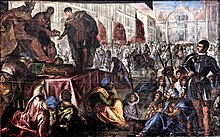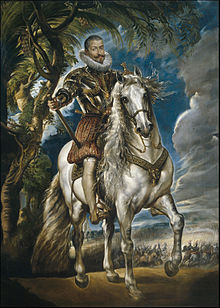
Mantua is a comune (municipality) in the Italian region of Lombardy, and capital of the province of the same name.
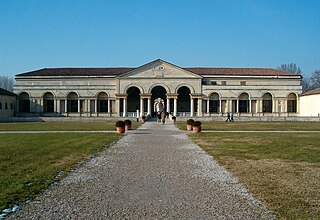
Palazzo del Te, or simply Palazzo Te, is a palace in the suburbs of Mantua, Italy. It is an example of the mannerist style of architecture, and the acknowledged masterpiece of Giulio Romano.

The Duchy of Mantua was a duchy in Lombardy, northern Italy. Its first duke was Federico II Gonzaga, member of the House of Gonzaga that ruled Mantua since 1328. The following year, the Duchy also acquired the March of Montferrat, thanks to the marriage between Gonzaga and Margaret Paleologa, Marchioness of Montferrat.

Sabbioneta is a town and comune in the province of Mantua, Lombardy region, Northern Italy. It is situated about 30 kilometres (19 mi) north of Parma, not far from the northern bank of the Po River. It is one of I Borghi più belli d'Italia. It was inscribed in the World Heritage List in 2008.

The Palazzo Ducale di Mantova is a group of buildings in Mantua, Lombardy, northern Italy, built between the 14th and the 17th century mainly by the noble family of Gonzaga as their royal residence in the capital of their Duchy. The buildings are connected by corridors and galleries and are enriched by inner courts and wide gardens. The complex includes some 500 rooms and occupies an area of c. 34,000 m2, which make it the sixth largest palace in Europe after the palaces of the Vatican, the Louvre Palace, the Palace of Versailles, the Royal Palace of Caserta and the Castle of Fontainebleau. It has more than 500 rooms and contains seven gardens and eight courtyards. Although most famous for Mantegna's frescos in the Camera degli Sposi, they have many other very significant architectural and painted elements.

Mantua Cathedral in Mantua, Lombardy, northern Italy, is a Roman Catholic cathedral dedicated to Saint Peter. It is the seat of the Bishop of Mantua.

Lorenzo Leonbruno, also known as Lorenzo de Leombeni, was an Italian painter during the early Renaissance period. He was born in Mantua (Mantova), an Italian commune in Lombardy, Italy. Leonbruno is most well known for being commissioned by the court of Francesco Gonzaga, Marquis of Mantua, and his wife Isabella d'Este. The patronage continued with their eldest son Federico II Gonzaga, who was the fifth Marquis of Mantua. Leonbruno was the court painter for the Gonzaga family from 1506–24.

Francesco Bonsignori, also known as Francesco Monsignori, was an Italian painter and draughtsman, characterized by his excellence in religious subjects, portraits, architectural perspective and animals. He was born in Verona and died in Caldiero, a city near Verona. Bonsignori's style in early period was under the influence of his teacher Liberale da Verona. After becoming the portraitist and court artist to the Gonzaga family of Mantua in 1487, his style was influenced by Andrea Mantegna, who also worked for Francesco Gonzaga from the 1480s. They collaborated to execute several religious paintings, mainly with the theme of Madonna and Child. The attribution of theportrait of a Venetian Senator was debatable until the last century because of the similarity in techniques used by Bonsignori and his teacher Mantegna. During the phase of his career in Mantua, there is an undocumented period between 1495 and July 1506 with no official record regarding his activities by the court of Mantua. Bonsignori's late style was decisively influenced by Lorenzo Costa in terms of form and color. He produced his last monumental altarpiece the Adoration of the Blessed Osanna Andreasi in 1519 shortly before his death.

The Eleven Caesars was a series of eleven painted half-length portraits of Roman emperors made by Titian in 1536-1540 for Federico II, Duke of Mantua. They were among his best-known works, inspired by the Lives of the Caesars by Suetonius. Titian's paintings were originally housed in a new room inside the Palazzo Ducale di Mantova. Bernardino Campi added a twelfth portrait in 1562.
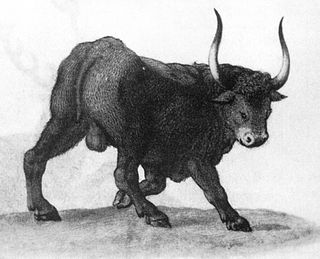
Teodoro Ghisi (1536–1601) was an Italian painter and engraver of the Renaissance Period, mainly active in his native Mantua. He specialized in paintings of animal and nature scenes.
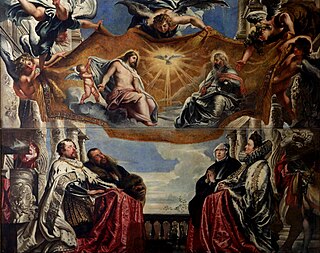
The Gonzaga Family in Adoration of the Holy Trinity is a painting by the Flemish artist Peter Paul Rubens, housed in the Ducal Palace in Mantua, Italy. The work was commissioned by Duke Vincenzo I Gonzaga for the Jesuit church in Mantua, while Rubens was his court painter.

Portrait of Federico II Gonzaga is a painting by Titian, who signed it Ticianus f.. Today in the Museo del Prado, Madrid, it portrays Federico II, Duke of Mantua who married in 1529; the portrait may have been commissioned for the occasion. The dog, a Maltese, is a symbol of faithfulness.

The Marquisate or Margraviate of Mantua was a margraviate centered around the city of Mantua in Lombardy. Ruled by the Gonzaga family from its founding in 1433, it would later be raised to the rank of Duchy in 1530.
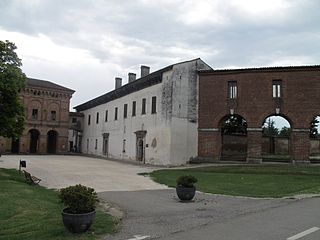
The Galleria degli Antichi and the Palazzo del Giardino are adjacent, contemporaneous, Renaissance-style buildings located on Piazza d`Armi #1 in Sabbioneta, in the Province of Mantua, region of Lombardy, Italy. Prior to 1797, the buildings were connected to the Rocca or Castle of Sabbioneta, and the gallery once housed the Gonzaga collection of antique Roman statuary and hunting trophies. While the architectural design of the gallery is striking, the richness of the interior decoration of the palazzo is also dazzling.

The Palazzo San Sebastiano is a 16th-century palace in Mantua. Built by the Gonzaga family, since 19 March 2005 it has housed Mantua's city museum.

The Castello di San Giorgio is part of the Ducal palace of Mantua. It is a moated rectangular castle, each of which's four corners has a large tower and the moat is crossed by three drawbridges.

The Basilica Palatina di Santa Barbara is the Palatine Chapel of the House of Gonzaga in Mantua, Italy.

The Fall of the Giants is a fresco by the Italian Renaissance artist Giulio Romano. Born in Rome Giulio Romano was a pupil of Raphael. In the year 1522 he was courted by Federico II Gonzaga, the ruler of Mantua, who wanted him as his court artist as he was especially attracted by his skill as an architect. In the year 1524 Romano moved to Mantua where he remained for the rest of his life. According to Vasari, Baltasare Castilliogne was delegated by Federico II Gonzaga to procure Romano to execute paintings and architectural projects in the city of Mantua, Italy. His masterpiece of architecture and fresco painting in that city is the Palazzo del Te, with its famous illusionistic frescos. In one of rooms of palazzo, the Sala dei Giganti Giulio Romano had depicted the Gigantomachy, an episode derived from Greek mythology. The fresco was created between 1532 and 1534 and it was based on Ovid's Metamorphoses, a narrative poem consisting of 15 books that was written in Latin around 8 C.E. The episode of Gigantomachy depicts Jupiter defeating the Giants with his lightning. According to other versions of the myth, Jupiter resisted the Giants' assault thanks to the intervention of Pan or of the asses of Silenus and Bacchus. Nevertheless, in the 16th century in Italy it was uncommon to hear Latin. Texts were changed in structure and substance when transferred to Vulgate, so it should be understood that Giulio Romano had used the vernacular translation of the Metamorphoses for his Gigantomachy in the Palazzo del Te. The subject was very popular in the fine arts of the Cinquecento, once for sure because of its inherent possibilities for effective aesthetic design, on the other hand because this myth was important for the self-image of a patron of that time expressing religious, moral, political ideas.




